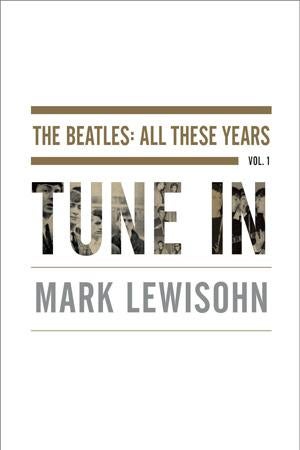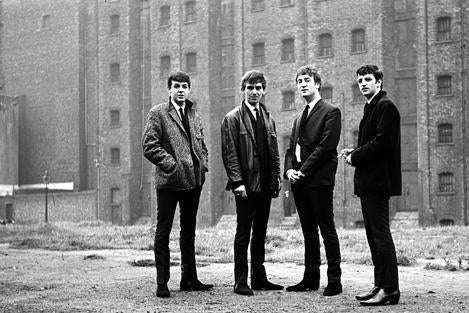The closest I ever came to a contact high from reading occurred the summer I was 14, curled up on my bed and pretending it was some submersible straight out of Yellow Submarine, staring gobsmacked at the pages of Peter Brown and Steven Gaines’ The Love You Make, a drugs- and sex-sotted ripsnorter of a Beatles bio. It was the first book on the band I ever read. And while I would go on to read, if not every other, then damn close to it, that sense of an illicit reading encounter—with me wondering if I had done something wrong in so willingly being funneled into this mad, psychotropic world—captured a kind of Beatlesesque spirit, quite beyond the let’s-all-drink-liquid-acid trappings. Even at 14, I understood that there was luridness there intended solely to shock and sell, but the book had so much in it that I’d return to it every few years, get caught up in the narrative all over again, snicker at the Satryicon-bits, and wonder who would eventually come along and write—insert posh Etonian voice—a proper, even scholarly bio, something to do for the Beatles what Gibbon did for Rome. Something Beatlesesque but more, serious and seriously funny, estimable, weighty, necessary, definitive, and, dare one say, canonical.
By my reckoning, there are four absolutely essential Beatles books: The Love You Make for that aforementioned spirit; Ian MacDonald’s Revolution in the Head for its clear-eyed analysis of each Beatles number (and its willingness to critically throttle some of them); and two by Mark Lewisohn: The Complete Beatles Recording Sessions, and The Complete Beatles Chronicle, the former giving a blow-by-blow account of each of the Beatles’ EMI sessions, and the latter giving a blow-by-blow account of just about everything the Beatles ever did and the day they did it on. So the news that Lewisohn is working on a three-volume bio—a gargantuan undertaking—has had me wondering if Lewisohn was set up to realize this kind of biographer’s star turn.

After all, EMI, the Beatles’ label, had given him access to the band’s original session tapes, so here was a guy who had heard stuff that not even all of the Beatles had heard (given that there were instances when not everyone in the band was present in the studio). I have no clue how many times I have lugged those Lewisohn books down from the shelf to skim over an entry, double-check a fact, remind myself who served as engineer on the day the regular engineer was out.
Even Beatles superfans are likely to wonder whether we really need another Beatles bio, and a three-volume one at that, with the newly released first part, Tune In, coming in at 932 knee-buckling pages. Lewisohn reportedly got a load of money for the project, but it’s a load of work. Well, a load of work from a certain point of view. A lot of this is simply cobbled together from the litany of Beatles books out there.
If you know the Beatles’ story arc, you are aware that despite the adulation, the chart-topping, the madcap tours, “We’re more popular than Jesus,” Yoko, the breakup—all of that which occurred between 1963 and 1970—the choicest parts of the band’s story are the early, pre-fame years, culminating with 1962. These are the hell-for-leather years, the period when a band from a grimy, bomb-scarred city—a city that didn’t exactly turn out world-beaters—defied long odds and commenced a quest that has something almost preordained about it. In this book, which focuses on 1957 to 1962, Lewisohn picks up on that supernal feel to the Beatles’ success, and at times his own wonder that all of this ever happened, with one amazing coincidence after another, feeds into our own. For instance, crucial, confidence-building early work—a tour as a backing band in Scotland—comes about “not on merit but because no one else could fill the bill and they shifted everything to make it happen.” A recurring moment, the defining scene of this book, which happens about a dozen times: In doubt, and in the dumps, with ostensibly no prospects to ever get anywhere, one Beatle turns to the others and says, basically, “Something’ll happen.” And then, boom: It does.
Huge chunks of the book work this way, and they can even get you pumped up, like an end-of-game sideline speech ushering in the unlikely comeback. And with his accounts of the crucial Hamburg visits, Lewisohn shows admirable restraint, too, focusing as much on the music, the experience that the band gained, and the relationships that they forged among themselves as on the drink and drug saturnalia that typically overrides this portion of the official history. In plain terms, the Beatles sucked when they went to Hamburg for the first time in 1960. They got the gig in the first place only because manager/impresario Allan Williams had no one else to send. But Lewisohn has a knack for underscoring the moment, the precise moment, when things change, and another rung of the ladder is attained. Sometimes he even does the math of those changes for us: “In seven weeks at the Indra, the Beatles had clocked up 205 stage hours—the equivalent of 136 ninety-minute shows at home. They were transformed. The spark was now a flame. Confidence, charisma, dynamism and fantastic unpredictability exploded from them. There was no one else like them, not in Hamburg, not in Liverpool, not anywhere in the world.”
The last sentence might sound hyperbolic, especially when you recall that the band was pretty much a rough-hewn covers band at this juncture, with a suspect drummer in Pete Best to boot. But he’s right, there wasn’t anyone like them, because no one came what they became.

Lewisohn’s musical analysis is hit-or-miss. I don’t see how “My Bonnie,” the song the band, billed as the Beat Boys, cut with Tony Sheridan, is one of the great early British rock and roll records. Granted, there weren’t a lot of great early British rock and roll records, but even if there were like four or five, at best the song was a little less terrible than most of the schlock that was out there. Then again, Lewisohn stumps for the undervalued late ’62 Star Club recordings as absolutely essential: “By nothing more fortunate than microphone placement, John’s rhythm guitar is unusually upfront, heard to be a hard, driving engine slicing through the songs.” Bingo. Go ahead and pull out the early records like Please Please Me and With the Beatles. The sonic architecture of the pre–Ed Sullivan Show Beatles is built around that chunka-chunk Lennon rhythm guitar.
Lewisohn’s own writing is built up from his enormous dossier of facts and anecdotes. He is more reporter/chronicler than prose stylist—even the zany moments with pilled-out rockabilly legend Gene Vincent don’t exactly crank it to 11 and the frequent flavorless writing undermines the book’s chance to be something more than his Recording Sessions and Chronicle—that is, something more than a book to sit on the shelf, that you take down to consult a detail, double-check a date. A reference book. Solid and trustworthy. But not remarkable, as I had hoped it would be.
This will do for what it is. Someone else will have to do something very different, I suspect to write the book that will sit beside the great histories of the French Revolution, the Civil War, Picasso, and Lincoln, or maybe—ideally?—come up with a whole new angle on how to write a Beatles book that will last as literature. The Beatles are players in that realm. I eagerly await the book that will prove it.
—
Tune In by Mark Lewisohn. Crown Archetype.
See all the pieces in this month’s Slate Book Review.
Sign up for the Slate Book Review monthly newsletter.
